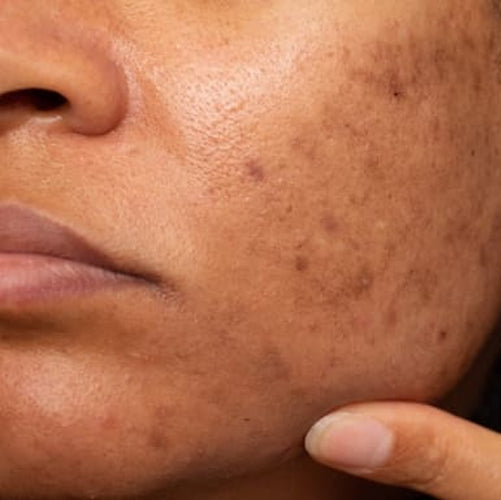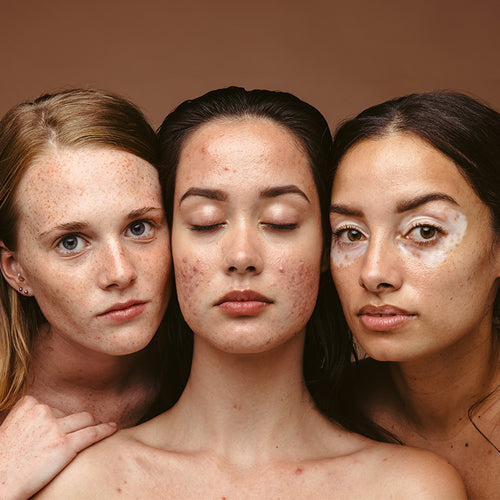Skin types and conditions still remain at the forefront of skincare advice, whether it’s given over the counter, in treatment rooms, or on TikTok and YouTube channels. However, Skin colour is often neglected when creating a skincare routine. Although skin colour does not dictate the use of specific products, understanding the different tendencies of skin colours is crucial to avoid complications like pigmentation and burning from incorrect use of products and clinical treatments. This is particularly true for darker skin tones, as there is limited information in the mainstream.
All skin types work to perform the same basic regulatory functions, but variations in skin tone introduce additional nuances that we need to be mindful of. Keep reading to find more about these differences and how they can be applied to take better care of your skin.
What Does 'Skin of Colour' Mean?
The Fitzpatrick Skin Phototype scale is broadly used by skincare researchers and dermatologists to evaluate which skin types respond best to their products and treatments, and types III-VI are considered to be skin of colour.
| Type | Description |
|---|---|
| I | Pale white skin, blue/green eyes, blond/red hair |
| II | Fair skin, blue eyes |
| III | Darker white skin |
| IV | Light brown skin |
| V | Brown skin |
| VI | Dark brown or black skin |
The basics: What are the differences between darker and lighter skin tones?
Melanin is a natural pigment found in human skin and mostly responsible for the perception of skin colour. Specialised skin cells called melanosomes can produce two types of melanin: Eumelanin, a black/brown pigment, and Pheomelanin, a yellow/orangey/red pigment.
Eumelanin is the dominant pigment in people with darker skin, while Pheomelanin is predominantly found in people with fairer skins, red hair and freckles. The ratio of the two types of melanin also affects skin tone. Other chemicals that influence skin colour are haemoglobin (red) and carotene (yellow).
Darker skin tones
The skin’s melanocytes, which produce melanosomes, which in turn produce melanin, are of equal quantity in all skin tones. But in darker skins, they are very active and produce large, separate, and densely packed melanosomes. They are distributed across every layer of the skin, causing its rich colour.
Lighter skin tones
Unlike darker skins, the melanosomes in lighter skins are usually small and appear in clusters. Found mostly on the outermost layer of the skin, they do not contribute to skin colour as much as they do for darker skins.
Why It's Important to Understand Darker Skin Tones
Post-inflammatory hyperpigmentation
Whenever trauma is afflicted onto the skin, whether from acne, eczema, insect bites, or injuries, the melanocytes in darker skin often have an extreme and hyperactive response. Hence, the dark spots left behind end up being as much of a concern as the inflammation itself. Although not harmful in itself, stubborn spots have a critical effect on self-confidence, self-esteem and even social interactions.
Risk of scarring
Similarly, the overproduction of protective skin cells in darker skin tones makes them more prone to hypertrophic (depressed scars) and keloid scarring (raised scars), which can affect self-confidence.
Risk of burning
A lesser-known concern for darker skin is the risk of burns from clinical treatments like laser hair removal or microneedling. Risk of such treatments should always be anticipated and professionals who are experienced with darker skin tones should be sought after.
Sun protection
Darker skin tones have a greater intrinsic SPF (8-13) than lighter skin tones (3.4). This fact often leads to misconceptions that those with darker skin do not need additional sun protection.However, SPF 13 is still insufficient to protect the skin from cancers. The lack of awareness has led to an increased morbidity and mortality rate associated with skin cancer in people of colour. Hence, more attention to photo protection and regular cancer screening is emphasised for people with darker skin tones.
Skin barriers
Ceramides, a lipid to retain moisture in the skin, are usually found in the topmost layer of the skin to maintain the skin barrier. But since darker skins have lower levels of ceramides, they are more prone to disruption through transepidermal water loss (TEWL), leaving the skin to feel rough and dry.
How does this affect your skincare routine?
While all skincare products suit any skin tone, an ideal skin care routine for dark skin tones includes products that target hyperpigmentation and barrier repairing ingredients, not forgetting sunscreens to seal in all your products during the day.
When we were designing our products at Sachi Skin to be inclusive for all, care for darker skin tones was a priority. That’s why we offer a product that’s dedicated to attacking stubborn dark marks with the Triphala Pigmentation Corrector. In addition to this, all our products also consider the sensitivities and needs of all skin tones making it suitable for everyone to use.
Stay tuned for our next article on Education, “Types of Pigmentation” if you wish to know more about hyperpigmentation.
Disclaimer: Please note none of the above constitutes medical advice. Always seek medical advice if you have any concerns or are looking to treat a medical condition.
References:



